Is the World’s killing the pipe band world? Part 1
By Andrew Berthoff
Part 1
[Originally published May 31, 2011]
In 1966, the Grade 1 Clan MacFarlane Pipe Band of St. Catharines, Ontario, made a trip to Scotland to compete in the World Championships. Setting out from Toronto International Airport, the group boarded a Douglas Turbo-Prop aircraft, a twin-engine propeller-driven plane that carried them, first, to Gander, Newfoundland, for refueling, and then on a 10-hour flight over the turbulent North Atlantic to Prestwick, Scotland. On arrival, the band boarded a bus, which arrived some six hours later at their ultimate destination, Kingussie, where the band would stay as it anxiously awaited the day of the contest at Bught Park, Inverness.
It was a complex and expensive effort, finally made feasible by the advent of commercial trans-Atlantic air travel. The novel idea of travelling 3,000 miles to compete at the World Pipe Band Championships, to test Clan MacFarlane’s talents against Scotland’s best, was strong enough to make such a complex and lengthy journey. Planning and saving took more than three years.
Nineteen-sixty-six was something of a breakthrough year for “overseas” bands competing at the World Championships. Clan MacFarlane were joined at the contest that year by Grade 1 rivals, City of Toronto and Worcester Kiltie of Massachusetts.
While Clan MacFarlane enjoyed its stay in Scotland, the competition didn’t go so well. The band finished eleventh in Grade 1, handily thumped by all but a few UK-based bands, not to mention City of Toronto, which made the list by finishing fifth, buoyed by a stellar second-place in piping. City of Toronto was topped in that category only by Scottish legends Muirhead & Sons, a band that was in the midst of its historic five straight World’s titles. But “The Clan” had gained a taste of the big-time; it had seen and heard the standard that would be needed to succeed, and began to understand the complexity of Scottish pipe band politics.
While the band had its sporrans handed to it on a platter, figuratively speaking, it was not humiliated. To the contrary, the band was energized. They returned to Ontario ready to practice harder, learn from the trip, and commit to compete again at the World’s as soon as possible. With one sip of the World’s elixir, it was hooked.
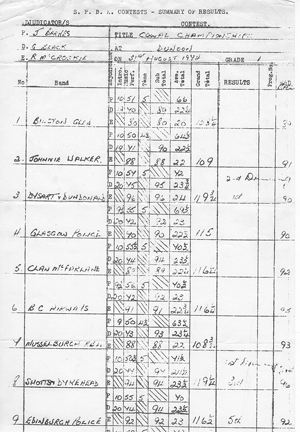 And their compulsion to compete at the World’s was passed along to others. As the word spread of the band’s trip, additional non-Scottish pipe bands were turned on to the intoxicating idea of travelling to Scottish Pipe Band Association championships to match talents with the likes of Shotts & Dykehead, Red Hackle, Muirheads and, of course, the illustrious city police bands of Glasgow and Edinburgh.
And their compulsion to compete at the World’s was passed along to others. As the word spread of the band’s trip, additional non-Scottish pipe bands were turned on to the intoxicating idea of travelling to Scottish Pipe Band Association championships to match talents with the likes of Shotts & Dykehead, Red Hackle, Muirheads and, of course, the illustrious city police bands of Glasgow and Edinburgh.
A small pipe band community would rapidly become the pipe band world.
There can be no doubt that the World Pipe Band Championships, as we recognize it today, is the biggest and most important event on the competition calendar. For those addicted to pipe band competition, there is no better single-day hit. The World’s produces an adrenaline and endorphin rush producing a high to last the year.
The World Pipe Band Championships are an undeniably successful event that will inevitably continue to get better and better as its owners, the RSPBA and the Glasgow City Council, look for ways to extend its reach and popularity. Every year the organizers flaunt the huge number of bands as a spectacle not to be missed — and rightly so. For many events, bigger is better, especially when the artists themselves even pay to have the honour to perform at it.
But while the World’s is the focal point for the pipe band world, does it come at a cost for the very well-being of the pipe band world itself? It might be fairly said that the trend of competing at the World’s has both a negative and positive impact on piping and drumming as art-forms. The desire to succeed at the one-day competition perhaps comes at a cost to the promotion and development of pipe band music.
And what impact is the competition having on pipe band regions and associations around the world? Do the benefits of the contest outweigh the possible damages inflicted on the health of various pipe band grades?
Has the very success of the World Pipe Band Championship halted the forward momentum of once-thriving pipe band regions and associations?
While acknowledging the unparalleled success of the World’s – and giving full credit to the spectacular competition – this article will attempt to weigh both the pros and the cons of the competition when it is considered on a broader level.
A game of numbers
RSPBA rules state that in order for a band to compete in Grade 1 it must have a minimum of eight pipers, two snare-drummers and one bass-drummer. The reality is that, if a band were to field such a paltry complement, they would be laughed off of the park. By all intents and purposes, they would be wasting everyone’s time – most of all their own.
In fact, the City of Washington Pipe Band did almost exactly that at the 2010 World Championships. The Grade 1 band competed with 10 pipers and, while it produced a decently tuned tone and good clarity of execution in its four-minute Qualifier contest MSR, it did not appear to matter. The band finished last or near-last from each of the four judges.
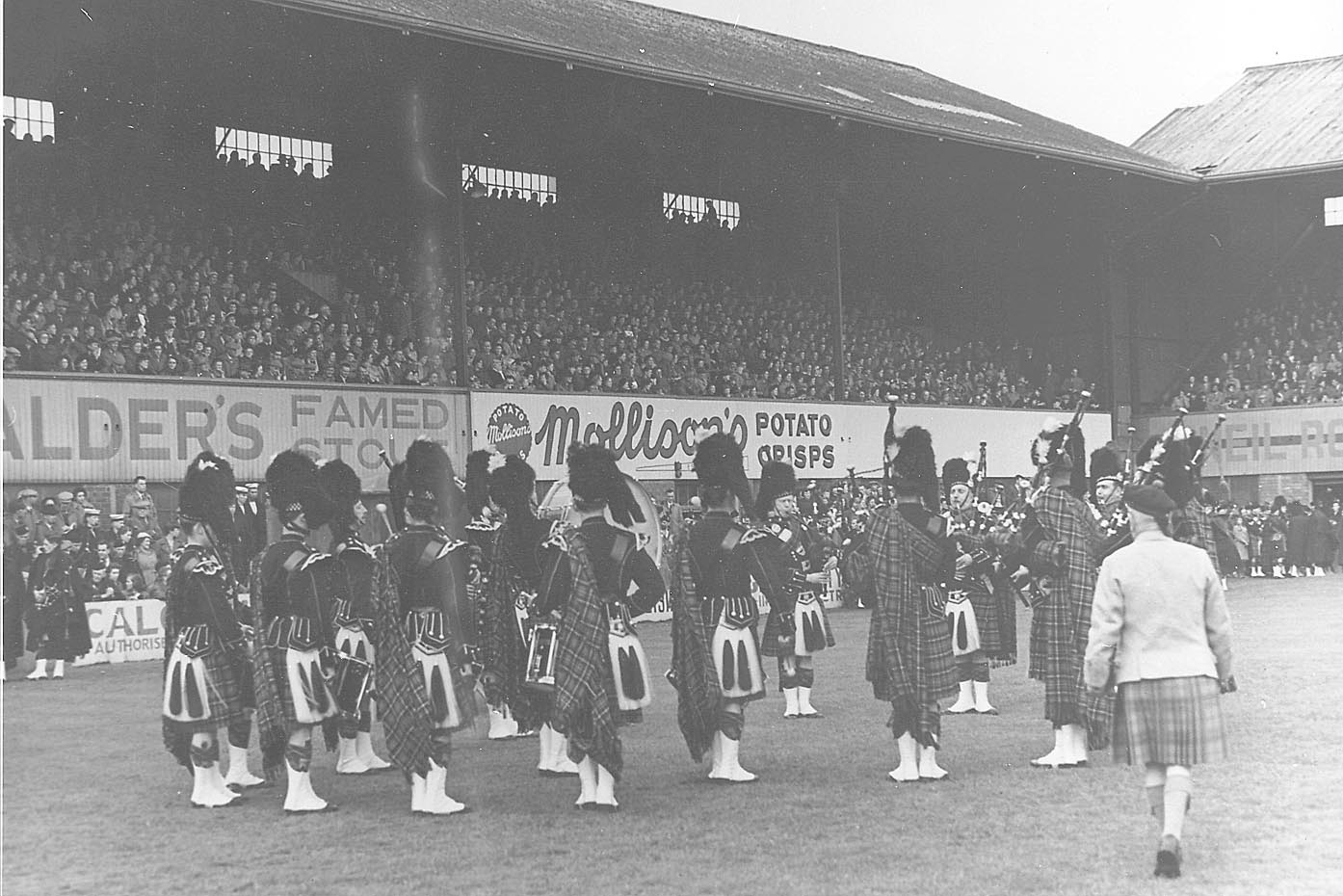
By no means did City of Washington deserve to make the Final, but the band perhaps was not given a fair shake simply because of its size. The band found itself downgraded by the RSPBA in the fall, so, if it wants to play again at the World Championships, it will have to be in Grade 2, regardless of whether its home association, the Eastern United States Pipe Band Association, maintains the band’s status in Grade 1. [NB: City of Washington disbanded a few years after its downgrade.]
To have a fighting chance in Grade 1 at the World Championships a band needs to field at least 16 pipers, six snare drummers and a mid-section of no fewer than four. The likes of the powerhouse groups Simon Fraser University, Field Marshal Montgomery and St. Laurence O’Toole assemble far more than those numbers, with pipe and snare sections routinely exceeding, respectively, 20 and nine.
So far, the apex of the numbers expansion was in 2007 when the 78th Fraser Highlanders (perhaps ironically the evolutionary offspring of the City of Toronto Pipe Band) produced a pipe section of 30 at the 2007 World’s, choosing from a pool of 36 pipers on the band’s roster. The massed band of that vintage of the Frasers was a major talking point of the year. While the 78th Frasers were spoiled-for-choice, many in other bands pooh-poohed the size as being simply too large, perhaps because, even with a pipe section roster of more than 20, there was no way that they could match such a massive band.
The 78th Frasers did not fare as well as it hoped, finishing fourth. Sure enough, so far no bands since, including the 78th Frasers themselves, have fielded such a large band. But while the notion of a pipe section of 30 has not taken hold (yet), the settling-out of numbers has meant that set-ups of at least 18, eight and five are an unofficial standard.
“The one trend that I do find problematic that may or may not be as a result of the World Championships is the growth in player numbers within bands over the last 10 years or so,” said Rod MacLean, pipe-major of the Grade 1 78th Highlanders (Halifax Citadel) Pipe Band of Nova Scotia. “With our relatively small population base, it has basically required us to bring in players from long-distance to stay competitive. This has had an impact financially and on the way we organize the band.”
The pressure, then, for Grade 1 bands competing at the World’s to gather as many players as possible has become enormous. Bands that once felt huge with 14 pipers, now are not satisfied unless they have at least 20 on the books. But how best to do that?
Most bands have taken the obvious tack: open their doors. Where once bands were the pride of a local community, members coming from the general vicinity, top bands today draw talent from hundreds, even thousands, of miles away. They recruit from areas that might not have a Grade 1 band for many miles, and they attract far-flung members with the allure of playing in the big-time.
There are no limitations in any association on roster sizes. So bands increasingly gather up as many players as they can. A huge roster, they feel, promotes competition within the band. When there are 35 pipers on the books and only 23 spots in the circle, players work harder. Meanwhile a dozen stand on the sidelines. A pipe section of 12 used to win the World’s. The over-recruiting practice is so severe with some bands that it has been likened to a “driftnet,” in which everyone is scooped out of the ocean of talent in a way that disrupts a delicate ecosystem.
There are cries from some for limitations to be put on the size of pipe- and drum-sections within bands. But unless the RSPBA and, thus, the World’s, starts the process, no association will willingly curtail the competitive chances of its member bands, and its members would not approve it anyway. So while the World’s thrives, the world’s associations increasingly struggle due to the pressure for bands to field large numbers. Conceivably, if section numbers were capped, then almost overnight dozens of bands struggling for personnel would be helped, or altogether new pipe bands would be started.
“For me, a cap on player numbers would greatly help to level the competitive playing field in this respect,” continued MacLean, “and this is where the World’s may well have its greatest impact. Not wanting to disadvantage their top member bands at the World’s, I believe associations take their lead from the RSPBA here and a maximum cap will only be put in place generally if the Scottish association does it first. In that one respect at least, the World’s and the RSPBA affect us directly.”
“Limits on sections or rosters in bands I think would be a good idea, but impractical for a couple of reasons,” said one prominent Canadian pipe band judge who spoke on condition of anonymity. “There probably would be very little chance of getting a pipe section limit small enough to have any real effect, and bands would easily find a way to get around roster limits by having a second band of some grade.”
The predicament in Scotland is somewhat different. While today there are 10 Grade 1 bands based in Scotland, representing a much larger pool in a smaller geographical area, that’s down from 13 in 1966 and far fewer than the 15 or so in the 1980s. There are bigger bands, but fewer of them.
“I’ve not had many players lured to other bands, but that would not bother me as they would only move if they were unhappy,” said the pipe-major of a Scottish Grade 1 band that does not regularly make prize-lists at RSPBA major championships. “Several of my team have been approached but stayed loyal as they can see the ‘bigger picture.’ I think the corps should be capped at 20 for the pipes and 12 for the snares. This would share the wealth.”
Certainly a large pipe band can be a glorious thing, presenting new musical possibilities. But is an SFU or SLOT or FMM of 23 pipers and 10 snares any more memorable than the Strathclyde Police of the late-1980s with 14 and six?
Mercenaries
Within the last few years there a trend has emerged: the mercenary pipe bandsman. With the pressure for top bands to field larger sections, some pipers and drummers routinely hook up with a different Grade 1 band if their usual Grade 1 band isn’t competing at the World’s. They increasingly do this just in time to satisfy the RSPBA’s two-week release policy. They learn up the music for the temporary band and often have their travel to Scotland covered in return for lending their services at the World Championships. When the World’s is finished, they go back to their usual band.
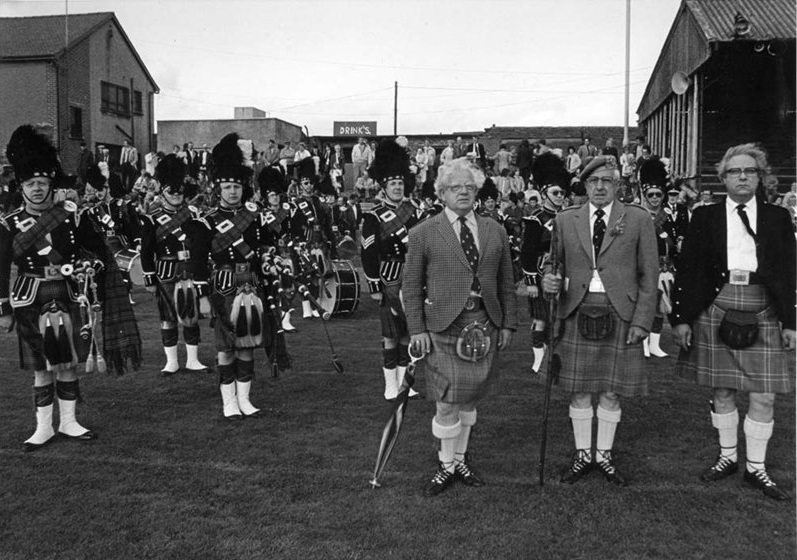
There’s nothing in the rules to prevent this action, and lending a hand to a group of friends and enjoying playing at the World’s should not be condemned. As long as the rules permit it, the temporary guest player routine is permissible.
That said, it probably does not foster camaraderie in the band the player left. After all, aren’t these pipers and drummers helping the competition? Yes, they’re not competing against one another on the day, but the two bands are in competition overall, and the sharing of players across a grade breaks down an unwritten – once sacrosanct – pipe band rule: you commit yourself to one band and you don’t help the enemy.
Perhaps no place has the effect of players-for-hire been felt more than in New Zealand and Australia. Because of the massive financial burden of getting to Scotland from the other side of the globe, most antipodean bands can make it there once every few years. And because their outdoor competition seasons are, literally, polar opposites, members routinely cross-pollinate from bands not attending the World’s to those that are. The local and RSPBA rules permit such temporary transfers, and in those countries the practice has become commonplace.
But at what cost? While one can contend that the inter-band swapping of players results in more camaraderie, it can also be said that a band’s sense of personality and pride is diminished. The fealty to the band and the team spirit that comes with it through competitive rivalry may go against a commitment to create something unique and special over a long period of time. The drive to do well at the World’s this year can result in a short-sighted, fleeting burst of quality, but perhaps little else.
But what’s a modern-day pipe-major to do? He’s struggling for numbers himself, and if he gets down on his all-star member for aiding the competition at a contest his band isn’t competing at, then he risks alienating and losing the player. It’s not dissimilar to major league sports. Team managers are loath to chew-out a top player for not hustling or having a bad attitude for fear of a revolt and the star player ultimately demanding a trade or transfer. The manager mollycoddles the players, turning a blind eye to what used to be an ethical impropriety.
Of course, the band that’s not competing at the World’s is the one that the temporary help is leaving – temporarily. Generally, upper-grade bands that don’t compete at the World’s do so because they’re challenged for strong personnel. And non-UK bands that don’t travel to Scotland to compete in the World Championships might be seen as lacking commitment, so new top-flight personnel are less likely to be attracted. It’s an unkind circle in which they’re caught.
Impact throughout the grades
It can be said that, overall, no other grade has been more affected by the pressure for Grade 1 bands to produce large section than Grade 2. Only 10 years ago, some 19 Grade 2 bands competed at the North American Championships at Maxville, Ontario. In 2010, only eight entered. There has been a steady decline, not only in entries at the biggest competition in North America, but in the number of Grade 2 bands in North America overall.
The decline is perhaps most pronounced in Ontario. Only three Grade 2 bands competed on its circuit in 2010.
There is strong evidence to suggest that, with Grade 1 North American bands desperate to assemble rosters and sections large enough to be viable at the World’s, they are taking players not from Grade 2 bands, but from those in Grade 3. Pipers and drummers who before would stay with their local band, coursing up through the grades with pronounced loyalty, these players are leapfrogging Grade 2, attracted to the siren song of Grade 1. The preparatory ground for Grade 1 that was once Grade 2 is now, more often than not, Grade 3.
The bragging rights that once came with making the cut as an accomplished member of a Grade 1 band today are today commonplace, Grade 1 members and their alumni are scattered all over North America.
And, so, Grade 2 becomes more and more threadbare in North America. The bands that compete in the grade today more often than not lurch from year to year with wildly differing standards. Grade 2 bands can build up a large and talented roster one year, only to see the whole thing collapse over the following winter, often a result of being impatiently unwilling to persevere in Grade 2 or unable to accept not winning in Grade 1.
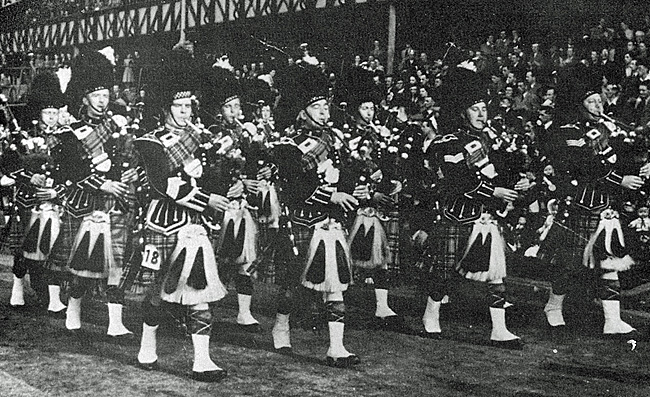
And because players are coming straight from the lower ranks to the top bands, relatively few Grade 3 bands are making a successful leap to Grade 2. And because there are fewer Grade 2 bands outside of the UK, there are relatively fewer bands promoted to Grade 1, so, rather than the number of bands in Grade 1 increasing, that grade, too, is in decline in more mature pipe band regions like British Columbia and Ontario. In terms of the number of bands competing in both Grade 1 and Grade 2, both are in decline.
Recently the Grade 2 Rocky Mountain Pipe Band of Calgary, which finished fourth overall at the 2010 North American Championships, this year has decided not to compete because of numbers. But the band can field the minimum numbers in each section; it just can’t come close to putting out 15-plus pipers and six snare-drummers – numbers that make a Grade 2 band realistically competitive. Rocky Mountain would rather not bother at all than toil against bands with a small battalion of players.
“My personal view is that there’s an ‘unwritten rule’ in terms of minimum numbers as far as being competitive,” said Rocky Mountain Pipe-Major Sean Somers. “The fact is, a small army of players is an impressive thing. Visually speaking – before a note is even played – it’s hard to compete with an eight-wide swath of pipers four rows deep. We bailed-out this year, because if we showed up with eight or 10 pipers to Maxville again this year, I think we’d get laughed out of the park. And it’s not just pipers either. Mid-sections especially, are under the same pressure.”
When asked if he thinks Grade 2 is a vanishing grade, Somers said, “If what pipers are doing here in Alberta is any indication, I’d say yes. In some cases here, players are making the incredible jump from Grade 3 and Grade 4 into the big leagues of the Grade 1 circle – more realistically, the sidelines of the Grade 1 circle, holding capes and water bottles in many cases, as they’re not ready to make the cut.”
The notable exceptions are in areas without a relatively dense population of Grade 1 bands. The United States has gradually added top-grade bands, certainly because of a rise in talent, but also, it might be said, because of a more widespread pipe band population. Recent arrivals to Grade 1 in the US like Oran Mor and City of Chicago perhaps don’t have the stress of losing players to rival regional bands, and can more securely build for their futures.
If that’s true, then the same can be said of a success story like Inveraray & District in the relatively remote Argyllshire region of Scotland. Inveraray has benefitted from having a long-range vision and foresight to build regionally. While a trip from Inveraray to Glasgow may seem just around the corner to the Canadian or American or Australian player, to a Scottish piper or drummer the journey can be unacceptably far.
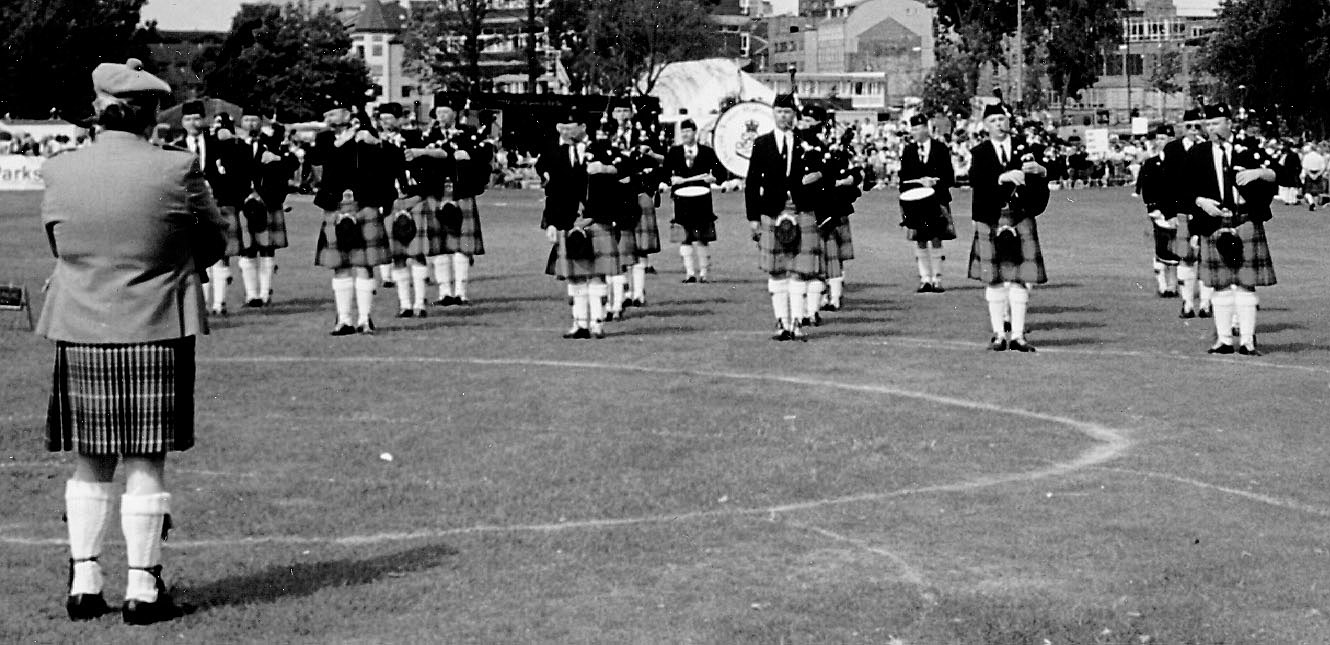
“Players have always gravitated to the big bands, but the current World’s situation has, in my view, increased the recruitment that goes on,” said a piper connected with a Canadian Grade 3 band. “One can’t buy back one’s youth, and if a young player wants to spend his or her time before career commitments and adult responsibilities in playing for a Grade 1 band, who can argue? But the necessity of large pipe sections makes the recruitment unrelenting, sometimes starting as low as Grade 3 amateur. And in more than a few cases leads to the recruitment of players who are very unlikely to ever play in a Grade 1 band but could be very useful to a lower-grade band.”
The pressure for numbers perhaps paradoxically impacts the overall pipe band scenes that are more densely populated, like central Scotland, Toronto and Vancouver. Several Grade 1 bands, including Boghall & Bathgate, Toronto Police and Simon Fraser University, have even eliminated their official Grade 2 feeder bands, drawing instead from their Grade 3 groups.
“One reason for the large pipe sections is often unremarked,” said a piper who is part of a Canadian band’s youth program. “Teaching in the schools in Scotland is producing large numbers of very well-taught players, taught by excellent and well-paid players at 10 in the morning, not by someone who has put in a hard day’s work and might well want to put his feet up and watch the Blue Jays. And so our bands feel under pressure to have the biggest and best pipe sections they can, and with what they see as a limited number of suitable players available, go after what they can with precious little thought for the bands the players are coming from.
“This makes it especially hard in Grade 3, which I call the ‘elephants’ graveyard of pipe bands.’ The good young players in Grade 3 bands can often play in Grade 1, which is even more attractive than it used to be with the whole World’s Week experience. And a band in Grade 3 is so far from Grade 1 that young kids think they will be grandparents before the band gets there, if it ever does. Once a band gets to Grade 2 it may be easier to keep their players as the band may appear to be almost there.”
Recently in Ontario well-established bands like the Grade 3 Durham Regional Police and the Grade 4 Brighton Legion have amalgamated, while the London Firefighters had their application approved to move down to Grade 4.
In unexpected places like Nevada, three Grade 4 bands merged to become one “superband.” The reason? The group wants large enough numbers to do well in Grade 4A. So two bands are sacrificed within a local association because of the perceived glory that comes with doing well in Grade 4A at the World’s.
In the big picture, can this be good for piping and drumming?
The far-flung membership
Forty years ago, Grade 1 bands almost exclusively comprised players from within a certain geography. Pipers and drummers played almost exclusively with the nearest band, and bands were closely identified with their home town. Villages were proud of their community pipe band.
Over the years, notably coinciding with the rising popularity of the World’s, Grade 1 bands have looked further afield for members. Years ago the large majority of members of top-grade bands were from a 30-mile radius. A player who would travel more than 75 miles to practice was an oddity.
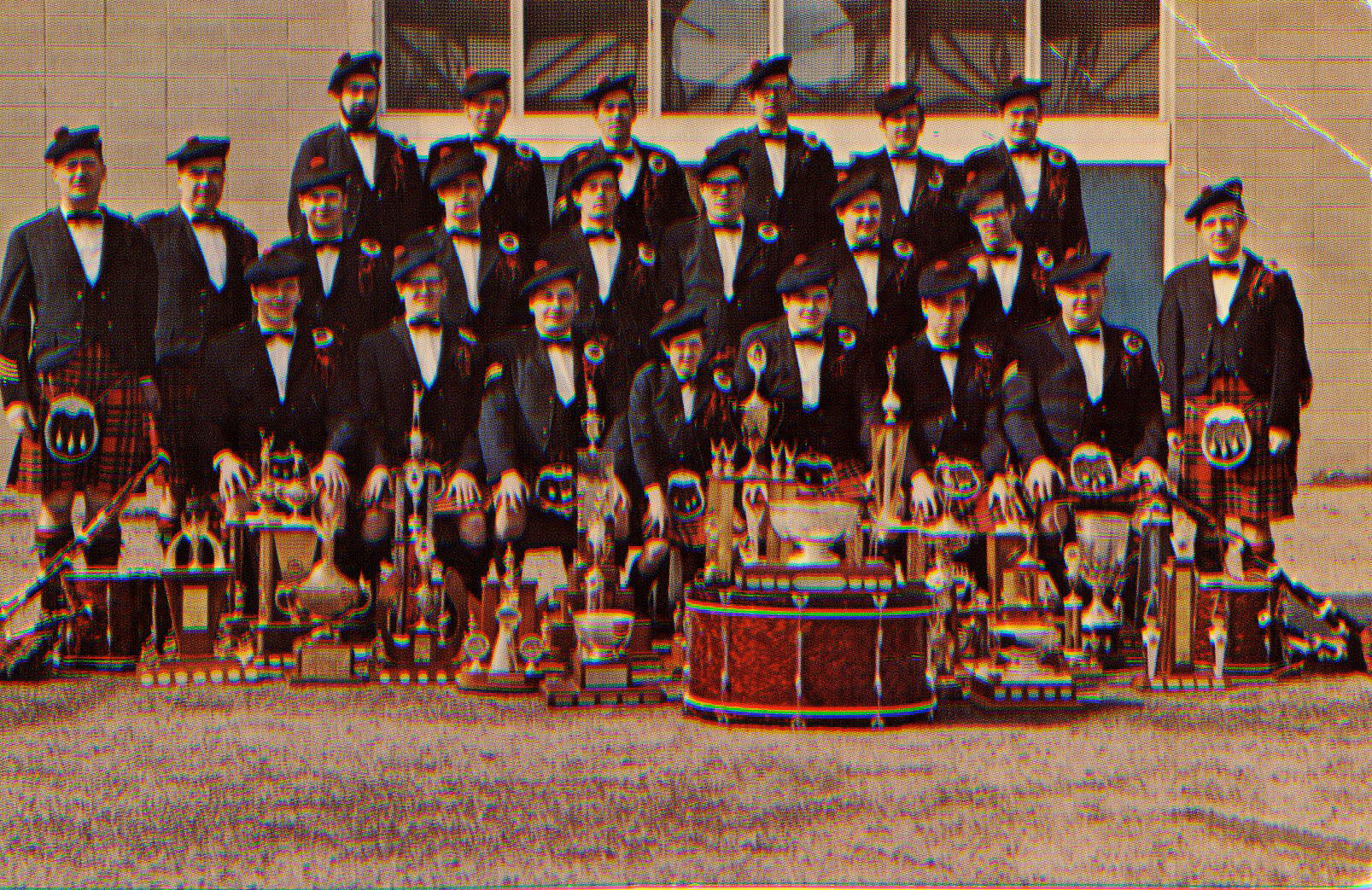
Gradually the catchment area for players has grown wider, coincident with the move to larger numbers dictated by what succeeds at the World’s. Where top bands previously practiced twice, even three times every week, by necessity these bands must reduce their schedule of practices. With such a widespread membership, it is impossible to hold regular practices with a strong representation of the roster attending.
Many opt for monthly or even bimonthly practices, often lasting the entire weekend. The music is handed out in the fall, and all members plan to attend weekend practices prepared to play, so that the two-day affairs really count.
While such an approach may allow bands to produce the numbers to stay viable, it comes at a cost to camaraderie. The concept of a close-knit group of pipers and drummers, maturing together, enduring thick and thin, reaping the heartfelt rewards that loyalty brings, has become an increasingly extraordinary idea. The social benefits of a band that once went beyond winning are now almost entirely wrapped up in doing well in fewer competitions. And to them the competition that matters more than any other is the World’s.
Even the world’s “big-three” bands – Field Marshal Montgomery, Simon Fraser University and St. Laurence O’Toole – readily welcome talented players from hundreds or thousands of miles away. They’re after talent, of course, but the practice sends a message to others that this is the way that prizes are won. Just as lesser bands mimic the musical styles of the big bands (more on this later), they also emulate the questionable practice of accepting personnel from essentially anywhere.
The strong sense of community pride that used to accompany every pipe band is increasingly rare. Even a Grade 2 band like Burnett’s & Struth, which set out in 2009 to work with only local players, has had to suspend activity due to the inability to maintain numbers.
Is the World’s killing the pipe band world? Part 2

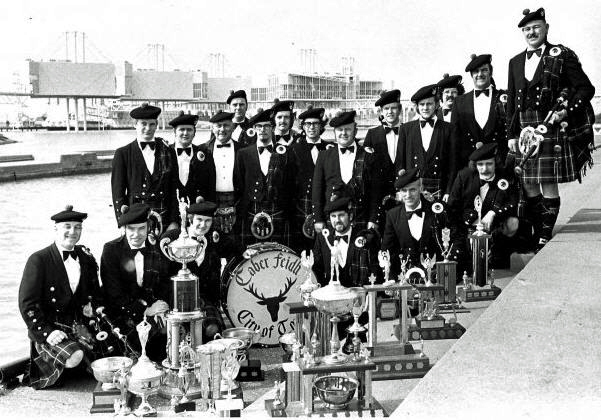
Great article Andrew. Certainly agree with you on the numbers game. My experience in Australia supports the view that a couple of what are effectively all star” bands sucks alot of the available talent out of the lower grade bands. It takes significant time
The pipe band community” is now a “global” community and not a local one. The “Arabian Awakening” that has changed everything in totolitarian regimes in the mideast has its reflection in the pipe band world. Everyone talks on line
Excellent work as always, Andrew. Appreciate the commenters’ thoughts as well. Me? I’ve always been more of a local” guy. But driving 3-5 hours each way to band practice for 20 years….even though those were the closest Gr I bands….? Was I a mercenary? Should I have tried to start a band locally? Played with a lower grade band? If you’re driving at the speed of light and turn on your headlights
Andrew, this is a great (and timely) article/editorial. It won’t change anything (but you know that, too). There’s simply too much to reflect on because you’ve covered so many bases. But overall you are on the money, in my opinion. What concerns me is the numbers at the top flight. We are starting to see a mirror image of all pyramid competitions and organisations outside of what we do. Take the English Premier League, for example. Those who have the money, thrive and dominate each and every year. In pipe bands, if the upper echelon open their doors to 20+ pipers, they become destinations and ‘tick the box’ ventures for the good players who may have previously adorned the ranks of lesser bands (and been of benefit there). There is a draw on the lower grades as a result, but we never see more than about 20 grade 1 bands at the worlds each year. They’re just bigger in size. One thing that seems to get lost on some is the amount of money required to bankroll the ‘modern’ pipe band. It seems that many people forget we are still on the fringe, whilst at the same time aiming for so much more. It’s ok for the few bands that have secured ‘sponsorship’ (aka someone in the band – usually high on the pecking order – supplies the band as a ‘loss leader’ for their business, or a corporate who will hang around for a few years at best). But the rest of us are out there selling raffle tickets and paying our own ways and dressing ourselves. And maybe people who spend thousands on a one-off contest like the worlds want greater satisfaction and return on their ‘investment’, so they pursue the apex bands. Look at the ‘composite’ bands that assemble in a truly ‘global’ sense – they never last because it’s a simple matter of not being good enough and the novelty wearing off. This is a direct result of aspiring to do well at one contest – the worlds. On a more local level, some bands take on new leadership, and the regulars that have underpinned the band are then pushed aside for the ring-ins to achieve expensive short-term goals. Do bands ever recover from those sorts of situations…? The one thing I do not like is the attitude that is starting to emerge where the ‘mercenary’ piper/drummer sees themself as a someone that can expect everything on a platter……in return for 11 minutes of (good!) music from them (hopefully!). I am starting to tire of the “what’s in it for me” attitudes and the diva-like whining that I hear from some people who are merely setting out to hunt trophies for themselves and who believe that pipe bands own money trees. I know several people who have played in 10 bands in as many years. And they continue to turn up and expect a full uniform, reeds etc to be ‘on tap’. Where do they think it all comes from..? It’s still coming from the hard toil and pockets of supporters and regular members in most cases. Personally, I think the world PBC’s are getting so big that they’re almost out-of-reach for anything but the ‘super bands’ – that are now destinations for good players who need to ‘tick the box’.
I think overall this very comprehensive report could benefit from a little more balance. It is not all bad in my mind as the current movement within pipe bands obviously has many good points as well. It is probably also wise to remember the pipe band world is a very dynamic place, which has, and always will change. There are certainly many problems and there always will be! Incidentally has there ever been a time when the pipe band world could be described as perfect? Folk will always do what is needed to enjoy music and reach the highest standard possible.
From my perspective, limiting the size of the band is paramount to maintaining the integrity of band competition. Why should a band need to recruit? This competiton was established to find the best local band in the world. if recruitment is from many miles away just to establish a large band, then local communities lose theri pride in their band. Hopefully the RSPBA will take the time to establish band size soon.
Band caps should help the situation to come back under control. Right now, as was pointed out, GrIII players go to GRI and generally hold water bottles (there are exceptions). With the exception of the thirsty, how does that help anyone? Wouldn’t it make more sense to gain experience and a proven track record in GRII before moving to GRI? Caps would help in this case by limiting the number of open spots available in each band thus allowing for a more even (and proper) distribution amongst the grades? A cap of , say, 30 max on the roster should help. Stay with the minimum of 8P-3S-1B and allow the bands to add up to 18 more players of any type at their own discretion. If they want 18 more tenors, go for it! If they want 18 more sides, so be it. Or maybe an ideal mix might be 18P 7S 1B 4T? Your choice… The other benifit would be the reduction in expenses to the bands since they don’t need to buy 30 chanters, 11 side drums, 19 tenor drums and 2 bass drums in addition to the associated uniforms, airline tickets, etc…. Trouble is, how do you get everyone to agree on any sort of cap? And are we infringing on freedom of expression/creativity? But then again, that’s what rules usually do.
Andrew, Here is an analogy that fits with your interest in Major League Baseball….. Would you rather sit on the bench for the New York Yankees and probably win a World Series or play every day for the Toledo Mud Hens? Most young people I deal with of the mellenial generation want it all and want it now. Cheers, Doc
I read again this wonderful piece and fell I could add another tuppence to the talk. I think capping the sections would be hard, yet capping the roster would prove impossible. And also, unnecessary – if a band’s pipe section capped at [say] twenty would travel with a roster of thirty pipers, it’d be down to each one of those putatively benched ten surplus men to decide whether they wanna actually play the Worlds in a Gr2 band [or even in another Gr1 one] or be at the sidelines holding water bottles and offering friendly ‘well-done’ nods. Also there is no way of disagreeing with Pipe Major Somers when he stated, ‘visually speaking (…) it’s hard to compete with an eight-wide swath of pipers four rows deep’. However this description fits more [in my auld heid] the massed bands parade than a competing single band entering the tee.